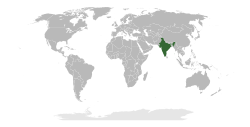Dominion of India
Union of India | |||||||||
|---|---|---|---|---|---|---|---|---|---|
| 1947–1950 | |||||||||
 | |||||||||
| Status | Dominion of the British Commonwealth | ||||||||
| Capital | New Delhi | ||||||||
| Common languages | Hindi, English and many others | ||||||||
| Government | Constitutional Monarchy | ||||||||
| King of India | |||||||||
• 1947-50 | George VI | ||||||||
| Governor-General | |||||||||
• 1947-48 | Earl Mountbatten of Burma | ||||||||
• 1948-50 | C. Rajagopalachari | ||||||||
| Prime Minister | |||||||||
• 1947-50 | Jawaharlal Nehru | ||||||||
| Historical era | Cold War | ||||||||
| August 15 1947 | |||||||||
| 1947-48 | |||||||||
| January 26 1950 | |||||||||
| Currency | Indian rupee | ||||||||
| ISO 3166 code | IN | ||||||||
| |||||||||
The Union of India, sometimes also known as the Dominion of India, was an independent state congruent to modern-day India that existed between 15 August, 1947 and 26 January, 1950. Although succeeded by the Republic of India, the term "Union of India" (or simply "the Union") is still used by the Indian judicial system to refer to the Indian government (as opposed to the government of the individual states).
When British rule in India ended in 1947, two dominions were created to succeed it: the Union of India and the Dominion of Pakistan. Created by the Indian Independence Act 1947 which was enacted by the British parliament, these states existed until the promulgation of their individual constitutions. In the case of India, this occurred on 26 January, 1950; the Republic of India came into existence on that date.
During the dominion phase, the British monarch remained head of state of both countries, and was represented in each by a governor-general. However, these governors-general were not also designated "Viceroys" as had been customary under the British Raj. Two governors-general held office in India during the dominion period:
Jawaharlal Nehru held office as prime minister (and head of government) of the Union of India during this period.
Partition of India
As the British granted independence to their dominions in India in mid-August 1947, the two nations joined the British Commonwealth as self-governing dominions. The partition left Punjab and Bengal, two of the biggest provinces, divided between India and Pakistan. In the early days of independence, more than two million people migrated across the new border and more than one hundred thousand died in a spate of communal violence. The partition also resulted in tensions over Kashmir leading to the Indo-Pakistani War of 1947.
Judicial usage
Under Article 300 of the Constitution of India, it is stated that "The Government of India may sue or be sued by the name of the Union of India". As a result, legal documents and court proceedings always refer to the government of the Republic as "the Union," even though the Union of India no longer exists as a national entity.


